“A Midsummer Night’s Dream” in Topanga
June 17, 2010
 One of Shakespeare’s most delightful and romantic comedies could have been written especially for the Will Geer Theatricum Botanicum, an intimate and unique outdoor amphitheater nestled in the heart of Topanga Canyon.
One of Shakespeare’s most delightful and romantic comedies could have been written especially for the Will Geer Theatricum Botanicum, an intimate and unique outdoor amphitheater nestled in the heart of Topanga Canyon.
Fittingly for the onset of summer this week, on Sunday, June 20 at a 3:30 p.m. matinee, the Will Geer Theatricum Botanicum once again presents a season’s premiere of its signature production, “A Midsummer Night’s Dream.” Audiences delight in the authentic forest setting for Shakespeare’s enchanting tale of fairies, mortals, romance, magic and mystery. Celebrate Father’s Day with a timeless classic presented on nature’s very own stage. The Theatricum Botanicum is located at 1419 Topanga Canyon Blvd. in Topanga. Here is the ticket information, and here’s how to get there.
Actor Will Geer’s cherished family project has a rich and storied history reaching back to the darkest days of the 1950s Hollywood blacklist, when Geer, like many actors barred by their personal politics from working under the old studio system, embarked on his own independent acting and performing endeavors. The result was his Theatricum Botanicum, originally a haven on his Topanga estate for other actors, singers and writers similarly disenfranchised from mainstream artistic employment. After Geer’s death in 1978, his family expanded the Theatricum’s artistic offerings and educational opportunities into a thriving performing troupe and an integral part of both the Topanga and the larger Southern California cultural community.
Opening night gala at the Hollywood Bowl
June 17, 2010
 The Hollywood Bowl’s 2010 Summer Season kicks off in style with an opening night gala on Friday, June 18. Three new artists will be inducted into the Bowl’s Hall of Fame: the legendary Carpenters pop duo, with Richard Carpenter accepting on behalf of his late sister, Karen; disco diva Donna Summer, veteran of several sold out concerts since her Bowl debut in 1979; and renowned pianist Jean-Yves Thibaudet, a frequent Bowl favorite. The inductees will be introduced by celebrity presenters, and concertgoers can look forward to additional surprises and fresh performances of both classic pop hits and classical music. Principal Guest Conductor Thomas Wilkins again commands the baton for the Hollywood Bowl Orchestra. And, of course, the evening will be capped by the Bowl’s crowd-pleasing fireworks spectacular.
The Hollywood Bowl’s 2010 Summer Season kicks off in style with an opening night gala on Friday, June 18. Three new artists will be inducted into the Bowl’s Hall of Fame: the legendary Carpenters pop duo, with Richard Carpenter accepting on behalf of his late sister, Karen; disco diva Donna Summer, veteran of several sold out concerts since her Bowl debut in 1979; and renowned pianist Jean-Yves Thibaudet, a frequent Bowl favorite. The inductees will be introduced by celebrity presenters, and concertgoers can look forward to additional surprises and fresh performances of both classic pop hits and classical music. Principal Guest Conductor Thomas Wilkins again commands the baton for the Hollywood Bowl Orchestra. And, of course, the evening will be capped by the Bowl’s crowd-pleasing fireworks spectacular.
Following Los Angeles Philharmonic tradition, all proceeds will support Music Matters, the Phil’s music education programs.
Tickets may be ordered on-line through Ticketmaster. This Hollywood Bowl seating chart will help you select a good spot.
The Hollywood Bowl is located at 2301 North Highland Avenue in Hollywood; see the Map and Directions page for full details on how to get there, or call (323) 850-2000 for additional information.
Posted 6/17/10
Summer Solstice, Southern California Style
June 17, 2010
The ancient Druids of Stonehenge had their own distinctive way of celebrating the Summer Solstice, the first day of summer and longest day of the year. In the Southern Hemisphere, that occurs in December, but in the Northern Hemisphere, that occurs—next week, on June 21!
Southern Californians have their own unique summer rituals, too. And one of these is the Franklin Canyon Solstice Hike, taking place on Saturday night, June 19 at 7:30 p.m. at Franklin Canyon Park in Beverly Hills. Here you can celebrate summer’s arrival with a moderately strenuous two-hour hike guided by a volunteer naturalist. He’ll unveil the mysteries surrounding the changing seasons, planetary alignments, changing constellations and all manner of natural and cosmic wonders.
Franklin Canyon Park is located at 2600 Franklin Canyon Drive in Beverly Hills. Call (310) 858-7272 ext. 131 for more information. Leave your dog at home, but don’t forget to bring a jacket and flashlight. Check for ticks when you’re finished, and watch out for the poison oak, always remembering “Leaves of three, let it be.”
Visit http://www.lamountains.com/ for more terrific daytime and evening programs exploring our wilderness and open spaces. And by the way, learn how you can support your mountain parks and become involved as a naturalist or other volunteer right here.
Posted 6/17/10
Father’s Day Weekend March for Peace
June 17, 2010
Blinky Rodriguez was looking at the demographics of town hall meetings devoted to activism in his community, and was troubled by what he didn’t see: Men.
“Normally, it’s always the mothers,” says Rodriguez, executive director of Communities in Schools for greater Los Angeles and the San Fernando Valley. So he started thinking about a way of “provoking men to stand up” against gang violence and for education and jobs.
He came up with one: a Father’s Day Weekend March for Peace. Now in its third year, the march will take place on Saturday at David Gonzalez Park in Pacoima from noon-4 p.m.
The mission is personal for Rodriguez, whose 16-year-old son, Sonny, was killed in a drive-by shooting in 1990.
“It’s a lot of work but the need is great,” Rodriguez says. And, in honor of the occasion, refreshments will include carne asada along with homemade rice and beans.
Details are here.
Dial 511 to get around town
June 17, 2010
A new phone and internet service to help travelers navigate the confusing and congested maze known as Southern California made its debut this week.
Unlike sites such as Sigalert.com and Traffic.com, or good old drive time radio traffic dispatches, the new Go511.com and 511 toll-free phone service offers freeway traffic reports augmented with information about ride-sharing, carpooling, bicycling and taking the bus or train.
It’s now in beta testing mode, which means that Ken Coleman, the Metropolitan Transportation Authority’s motorist services program manager, wants to hear from you on what works—and what doesn’t—in the new service. The system offers prompts for feedback both on the phone and on the website.
Since billboards and other publicity for the service started rolling out, 511 usage is growing, topping 20,000 calls on Tuesday. Between 400 and 500 users have offered comments, two-thirds of them positive, Coleman said. Those who didn’t like it were frustrated by things like having the system’s voice recognition technology offer them travel times between two freeways rather than specifics on congestion at one point along the freeway.
The initiative is being funded for a 10-year period with $30.8 million from the Los Angeles County Service Authority for Freeway Emergencies (LA SAFE.) Most of the funds had previously been directed toward supporting a network of freeway callboxes, which are being used far less frequently these days because of the proliferation of mobile phones. (Coleman said L.A. County, which once had 4,500 callboxes, now has 1,700. In the early ‘90s, he said, 90,000 calls a month were made from the boxes. Now that number is closer to 2,500 calls a month.)
Metro’s partners in the 511 system include Caltrans, the CHP and transportation agencies in Orange and Ventura counties.
The 511 automated phone system—to be used hands-free while driving, of course—covers Los Angeles, Orange and Ventura counties, while the website offers information on San Bernardino and Riverside counties as well. Upcoming improvements include voice recognition for Spanish language prompts and smart phone applications, including a configuration of the website that works on a mobile phone.
Ultimately, Coleman envisions tapping into more sources of data to offer a comprehensive, traveler-focused service that would assist not just the region’s commuters but also tourists arriving for a visit.
Southern California, he said, “can be a very daunting place to navigate if you have no idea.” As those who live here know only too well.
Posted 6/16/10
His body was broken but not his will
June 16, 2010
When Tom Tindall thinks about life and death these days, he knows the distinction can sometimes be measured in inches and seconds.
“A lot of times people come close to death,” says Tindall, one of Los Angeles County’s top officials. “A lot of times, the truck just misses them and they go on with their lives. The truck didn’t miss me.”
In early April, while Tindall and his wife were touring Nepal on a motorcycle, he was struck from behind by an out-of-control truck that launched him into a concrete wall. He suffered three fractured vertebrae in his neck, broken collar bones on both sides, a cracked sternum, a broken left scapula, a separated shoulder, eight broken ribs and two punctured lungs, one of which collapsed completely. The other functioned barely enough to keep him alive.
“Breath,” he says, “was my struggle.”
Remarkably, just 11 weeks later, Tindall has now begun to return to his job as director of the Internal Services Department, whose 2,000 employees are responsible for everything from information technology services to the maintenance of county buildings. Tindall was named ISD’s director in 2008, after more than a decade of work with the county.
“I refuse to believe that I cannot come back 100% from this thing,” says the lanky 60-year-old, an avid runner and hiker. “Two weeks after the accident, after trying to walk, I thought to myself that I’m going to be in a wheel chair for the rest of my life. But then I told myself, ‘No!’ This is something I need to keep working on and be positive about. It crossed my mind to go on disability but then I wouldn’t be where I am now—getting better.”
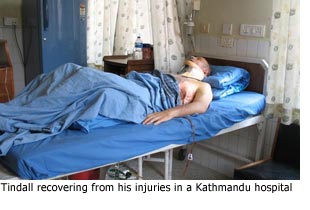 Looking at Tindall these days, you’d be hard pressed to see any evidence of the trauma that nearly killed him. The only outward sign is that he now tilts slightly to the left, the result of a fractured shoulder blade that will require extensive physical therapy. But without a shirt, he says, it’s not so pretty. “I look like Frankenstein,” he says, because of scars and indentations from broken bones.
Looking at Tindall these days, you’d be hard pressed to see any evidence of the trauma that nearly killed him. The only outward sign is that he now tilts slightly to the left, the result of a fractured shoulder blade that will require extensive physical therapy. But without a shirt, he says, it’s not so pretty. “I look like Frankenstein,” he says, because of scars and indentations from broken bones.
Tindall’s recovery is all the more remarkable because of the accident’s location—far from the world of sophisticated Western medicine—in the village of Itahari in southeast Nepal.
Tindall and his wife, Okyo, arrived there late in the afternoon on April 4, Easter Sunday, the fourth day of a journey that began in the Nepalese capitol of Kathmandu. This was Tindall’s third trip to Nepal, his first as part of a small group touring on motorcycles.
When they rolled into Itahari at around 4:30 p.m., Tindall says his wife, who was riding on the back of his motorcycle, developed a cramp. Tindall suggested she take a seat in the pace car that had been driving behind them with extra gasoline—a move that potentially saved her from the kind of physical wreckage that was about to claim her husband.
As the group began slowly making its way through town, a truck apparently failed to recognize that traffic had slowed and plowed into Tindall.
“Next thing I know,” Tindall says, “I woke up in a police vehicle transporting me to a clinic.”
Thirty miles later, they arrived at that clinic only to learn that the X-ray machine was broken. The next day, a helicopter transported him back to Kathmandu. On the advice of a locally-based American doctor, he was admitted to B & B Hospital, where, among many other things, his vertebrae were fused and wired together. He remained in Nepal for a month, until his lungs had improved enough for him to be flown back to the U.S. During that time, he says, L.A. County Chief Executive Officer William T Fujioka often checked in with him.
In recent days, Tindall, a former Army paratrooper, says he’s begun getting back in shape, walking two miles in the evening as well as going to physical therapy several times a week. He’s now in the office on many days, meeting with Internal Services staffers and getting the department ready for one of its newest jobs—administering a program to help homeowners finance solar energy installations through a special loan program.
On a deeper level, Tindall says, he’s still reflecting on how he’s been changed by his near-death experience in the land of Mt. Everest.
He says that, in his darkest hours, he prayed for help when he was struggling to breathe, despite the religious doubts he’s harbored throughout the years. But to his surprise, he says, “I found comfort, and it moved me closer to some kind of sense that you can give yourself over to the unknown…I don’t know how you can go through something like this without a renewed view of your life and its connections to something bigger.”
Posted 6/16/10
Sky’s the limit this weekend
June 16, 2010
 It may not be the dawning of the Age of Aquarius—or even the latest flyover by Halley’s Comet. But there have been some pretty spectacular celestial bodies on display in the night skies this spring. And this weekend brings some great opportunities to ogle them.
It may not be the dawning of the Age of Aquarius—or even the latest flyover by Halley’s Comet. But there have been some pretty spectacular celestial bodies on display in the night skies this spring. And this weekend brings some great opportunities to ogle them.
Saturn, Mars, Venus and the moon all will be visible—weather permitting—during a Friday night hike and sky-gazing session billed as “The Royal Flush in Planets” at the Upper Las Virgenes Canyon Open Space Preserve.
The evening will be led by amateur astronomer Pat McQuaid, a volunteer interpreter who hosts monthly stargazing sessions at the park. (It’s free, but there’s a $3 charge to park. Details are here.)
After a short, moderate hike, participants will get to look through McQuaid’s powerful 11-inch telescope, similar to those used at the Griffith Observatory.
McQuaid, a recently retired grocer who’s been looking skyward since he was a kid growing up in Chatsworth, calls the planetary lineup “an extravaganza in the sky.”
And (thank your lucky stars) the extravaganza also can be viewed Saturday at one of the Griffith Observatory’s free monthly public Star Parties.
Tony Cook, who writes the Sky Report for the observatory’s website and hosts its monthly “All Space Considered” briefing, says the timing is right to see Venus, Mars and Saturn, along with the bright stars Regulus and Spica, “basically in a line.”
“It does give a wide variety of things to look at,” Cook says. “And the moon is always exciting to look at.”
Looking at planets and the moon in photos and on TV is fine, but is no match for first-hand observation, McQuaid says: “This is the real deal. There’s nothing in front of that telescope except air, space and then Venus.”
And even city dwellers can share the experience.
“Those days of lying on my back in my backyard in Chatsworth and looking up at the Milky Way are long gone,” McQuaid says. “But people would be surprised at what you can see, especially in our parklands.”
Posted 6/16/10
L.A. rescue dog stars in new book
June 16, 2010
She came from the back streets, just another small-town runaway on the move and trying—unsuccessfully—to stay one step ahead of the law.
Now she’s hit the big time in L.A.
Her name is Pearl, and this 3-year-old Labrador retriever’s up-from-the-shelter life story is a real gem.
She’s a rescue dog, with a job and mission. This year, she traveled to Haiti to help find victims of the devastating earthquake as a member of the elite Los Angeles County Urban Search and Rescue task force.
It’s like something out of a storybook. And thanks to a teacher’s aide and a class of artistic second graders in Northern California, Pearl’s inspiring tale actually is one: a 24-page book called “A New Job for Pearl.”
The book was written by teaching volunteer Allyn Lee and exuberantly illustrated by Connie Forslind’s students at Rancho Romero Elementary School in the Contra Costa County town of Alamo.
“We’re really thrilled to be able to share Pearl’s story,” Lee says.
Pearl and her handler, Topanga-based L.A. County Fire Captain Ron Horetski, were part of the search and rescue squad known as CA-TF2, which spent 15 days in Haiti and drew widespread praise for its expertise and heroism.
 But not so long ago, as the book notes, the 62-pound Pearl was just a hyperactive young Lab in the Eastern Sierra town of Portola, a serial runaway confined to the local animal shelter.
But not so long ago, as the book notes, the 62-pound Pearl was just a hyperactive young Lab in the Eastern Sierra town of Portola, a serial runaway confined to the local animal shelter.
Identified as a potential rescue dog for her high energy and willingness to please, Pearl, or Black Pearl, as she was called, passed rescue-dog tests that earned a trip to the National Disaster Search Dog Foundation for six months of intensive training.
“She is a ball of fire with so much energy,” says the foundation’s executive director, Debra Tosch.
The Ojai-based non-profit group trains dogs for search and rescue teams around the nation, including all of the animals used by the L.A. County Fire Department.
Pearl graduated in 2008 and was teamed up with Horetski, a captain stationed at the county’s Fire Station 69 in Topanga. She lives with his family and commutes with him. Haiti was her first big mission.
Lee got the idea for the book after spotting media reports about the dogs of the CA-TF2 team in Haiti, where the task force was known as USA-2. The search dogs fit neatly with a lesson on wolves she’d just taught, says Lee, a former zoo docent who has taught a weekly animal-science lesson at Rancho Romero for 16 years.
“I’m always looking for news stories that say how important animals are to us,” she says.
Lee had written two earlier books with Forslind’s classes, telling made-up stories about animals who aided people after the Indonesian tsunami and Hurricane Katrina.
Those were fiction, but Pearl’s story was real.
Searching the Internet, she picked Pearl as the book’s protagonist not just because of what she did in Haiti, but also to focus attention on a shelter dog that could easily have been euthanized if it hadn’t been rescued.
“I really wanted the story to be about a shelter animal,” she says.
She phoned Horetski, by then back from Haiti, then wrote the story and assigned the illustrations to the students. By April, they’d finished. Donations covered the printing costs.
Horetski was stunned when he received a copy of the finished book. “I was expecting a bunch of pictures stapled together,” he recalls. “I thought, ‘Holy smokes, this is really fantastic.’ ”
The class hopes to raise $10,000 from sales of the $10 book to cover the costs of training another rescue dog. So far they’ve raised about $6,000 since the book was published in early May. For more info please refer to their website.
The book only touches briefly on Haiti because the grisly work was too graphic for second graders.
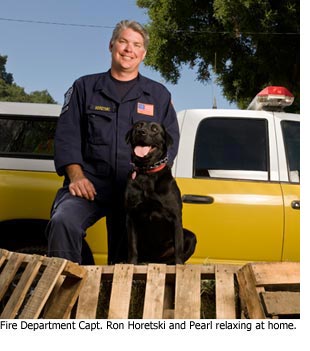 As Horetski says, Pearl often had to work amid human remains. She didn’t discover any of the nine victims the team rescued, but worked at dozens of sites including once locating a living victim who died before rescuers could complete a rescue.
As Horetski says, Pearl often had to work amid human remains. She didn’t discover any of the nine victims the team rescued, but worked at dozens of sites including once locating a living victim who died before rescuers could complete a rescue.
Last week, the second grade artists got to meet the star of their book when Horetski and Pearl flew north to Rancho Romero.
When the dog walked into the classroom, tail wagging, the second graders all screamed “Pearrrrllll!”
“They went absolutely nuts,” says Horetski, who showed off the dog’s obedience training and had her climb a ladder in the classroom before letting her play with the students.
“The kids were amazed by her energy,” Lee says.
Forslind, who is retiring this week after 39 years, says that because her students had never seen Pearl, it was only when the dog came to class that their storybook heroine became real.
“They were able to see that this really is a true story,” Forslind says. “My students were just thrilled.”
Posted 6/16/10
Future of Olive View TB ward in doubt
June 15, 2010
Los Angeles County is spending more than $16 million to build a dedicated tuberculosis ward that also could serve as a treatment center to isolate victims of a bioterrorism attack.
But something’s missing: people to staff it.
With construction on the ward almost done and an opening to the public possible by January, 2011, there’s been no appropriation of the $2.4 million it would take to operate the facility in its first six months. The project is part of the effort to build a new emergency room at Olive View-UCLA Medical Center, at an overall cost of $53.2 million.
A lot has changed since the project to build the ward was launched in 2004. Tuberculosis cases have continued a steady decline while money’s gotten a lot tighter, with the county Department of Health Services now facing a $400 million deficit in the coming fiscal year.
The health department did not include a request to staff the unit as part of its 2010-2011 budget proposal “because of the fiscal issues at the moment,” said the department’s interim director, John F. Schunhoff.
Still, two supervisors—Zev Yaroslavsky and Michael D. Antonovich—have indicated they want to make sure there is funding to get the unit up and running when final changes to the county budget are made in September. Both Supervisors have advocated for full funding by including the TB ward’s staffing in their “unmet needs” lists submitted as part of the budget process. (For all the supervisors’ full lists, click here and scroll down.)
Unless funding is found, the 15 new Olive View isolation rooms will likely sit idle. That, in turn, could place pressure on hospitals elsewhere in the system, which must provide bed space to some infectious TB patients until they are medically cleared to leave.
Consolidating TB care in one facility would be an efficient way to make day-in, day-out use of a facility that would have an important mission during a disaster like an anthrax attack, said Carolyn Rhee, chief executive officer of the county’s ValleyCare Healthcare Network, which includes Olive View. The ward also would free up isolation beds at other county facilities for patients who need them.
The county hospital system currently has 295 isolation rooms—in which negative air pressure keeps infectious airborne particles from spreading beyond their walls.
Schunhoff noted that a dedicated facility could offer better care to TB patients because of its specialized nature. However, facilities to treat the disease—once widely feared and commonly known as consumption—have become increasingly rare, as noted in this recent New York Times article about a Florida facility that is the last of the country’s original TB sanitariums.
Los Angeles County lost its only dedicated tuberculosis ward when High Desert Hospital in Lancaster closed to inpatients in 2003. Olive View itself started off as the county’s tuberculosis sanitarium when it first opened in 1920.
But times have changed. In a June 7 letter to supervisors, County Chief Executive Officer William T Fujioka said the years-long decline in TB cases means that the number of patients eligible to be transferred to the new Olive View facility, which would have a capacity for 30, “is calculated to be as low as 6 and rarely more than 12.” The letter estimated that the county would receive some reimbursement from Medi-Cal or Medicare for treating a majority of the patients but said that would not be enough to offset the costs of operating the facility.
Tuberculosis, which preys on people with weakened immune systems, was on the rise during the worst years of the HIV epidemic, hitting a peak of 2,198 cases in Los Angeles County in 1992. As the HIV crisis was brought under control, TB steadily declined, with 706 cases reported countywide last year.
 Public health officials say that’s good news—but no reason to be less vigilant about a disease that infects one-third of the world’s population and kills nearly two million people a year.
Public health officials say that’s good news—but no reason to be less vigilant about a disease that infects one-third of the world’s population and kills nearly two million people a year.
“When I trained at County Hospital in the ‘80s [when the AIDS epidemic was raging] people died left and right, like flies,” said Dr. Rashmi Jan Singh, assistant director of the county’s Tuberculosis Control Program.
“It’s still around, and just waiting for opportune conditions to create problems.”
So vigorous efforts are needed to keep TB in check, including making sure that patients continue treatment long enough to get well and avoid infecting others.
That can be a challenge, particularly when dealing with homeless people with substance abuse problems, who are among those likely to contract TB in Los Angeles.
“It’s really complex,” Singh said. “Patients take off to use drugs, to use alcohol. We have to bring them back.”
The disease is curable, but patients with active pulmonary tuberculosis must remain isolated until they are no longer infectious—which can present a problem both for the public health workers trying to make sure they take their medicine and get well, and for the hospitals that need that bed space for acutely ill patients.
Most hospitalized TB patients can leave the hospital once the acute phase of their treatment is concluded, and finish taking their medicine at home. But that’s not an option for some, including the homeless and those who live with small children and people with compromised immunized systems, like those with HIV and diabetes, who are most vulnerable to the disease. For them, an extended hospital stay is often unavoidable.
And even now, with effective treatments available, the disease can take a devastating toll.
“Its social impact is sometimes incredible,” Singh said, recalling a case in which a 28-year-old woman who hadn’t acted on her symptoms early enough died after spending weeks in intensive care at Olive View. The woman’s 10-month-old baby was infected as well, but survived and is still being treated.
“It devastated this family,” Singh said.
So from Singh’s vantage point, a dedicated TB ward at Olive View would be an invaluable weapon in an ongoing war.
“For us, as TB control,” she said, “it would be a great thing.”
Posted 6/15/10





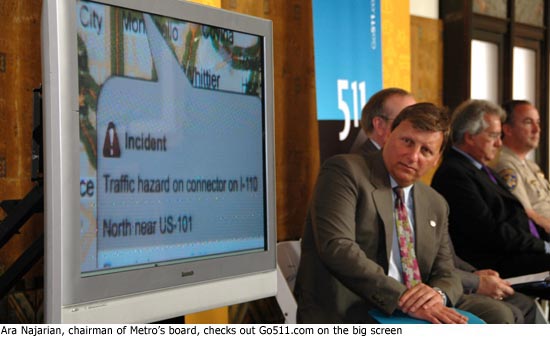
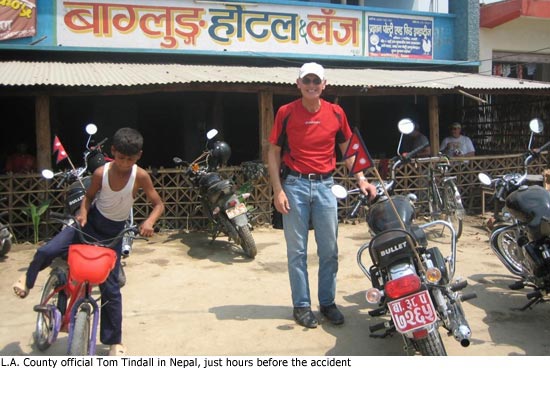
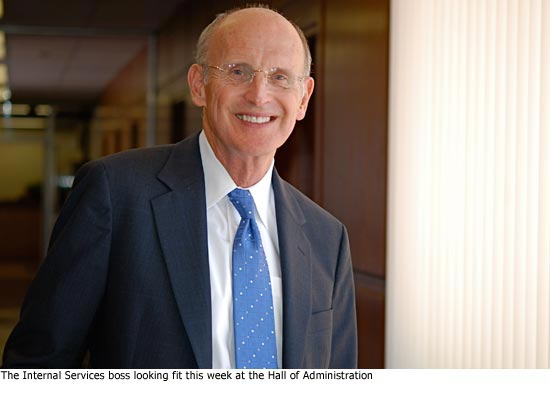
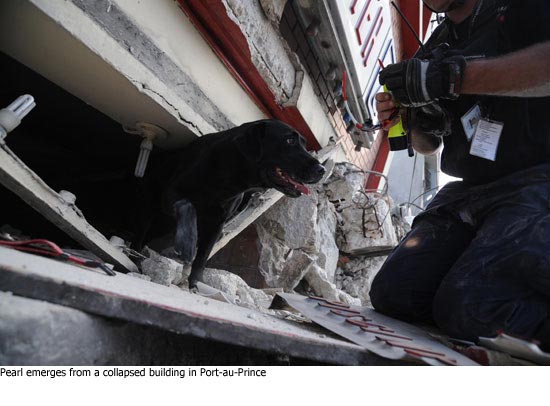
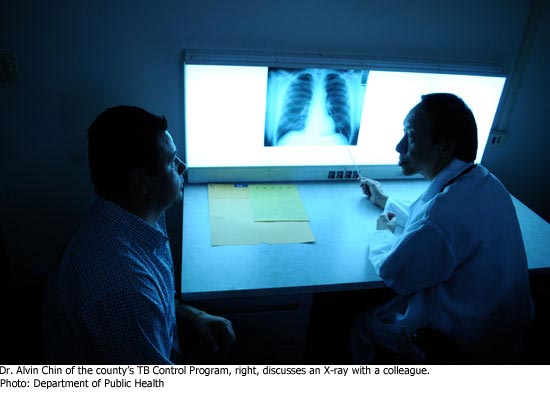





 Check for the latest closure information
Check for the latest closure information








